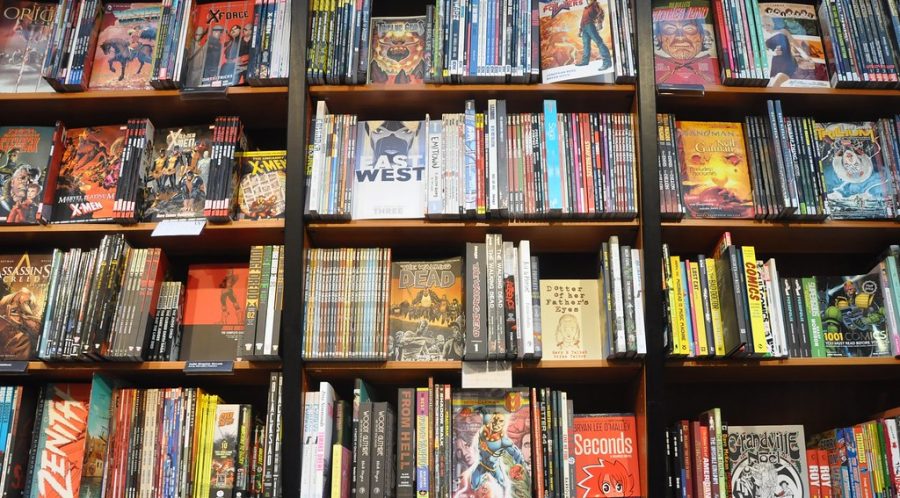Bowé’s Favorite Graphic Novels
February 19, 2020
Trigger Warnings: Some of these graphic novels include sexual and violent content, namely “This One Summer,” The Sculptor,” “Building Stories,” “The Tale of One Bad Rat” and “The End of the World.”
Like many other art majors, I can’t get enough of magnificent drawings. Seeing clever advertisements, colorful street art and digging through festivals and online forums for visual content makes me tick. In my opinion, everything in the world could use more flourish and detail to highlight beauty and incite intrigue. Just as I like everything else with illustrative flair, I’m always on the hunt for narrative fiction accompanied by visual art. Though I’ll never cease to be impressed by talented writing, something about such writing made to interconnect with another medium makes my heart sing. While this ranges everywhere from digital literature to picture books and even film, graphic novels achieve this connection between stories and imagery like nothing else. If you’re like me — consistently craving pretty pictures and moving tales — here I’ve put together my own list of some of the greatest graphic novels I’ve ever discovered.
The Gigantic Beard That Was Evil
Who knew that such a simple premise as a man whose beard won’t stop growing could make for the ideal scenario to one of the most unnerving and thought-provoking stories that I, at least, have ever read? Stephen Collin’s debut takes on an absurdist mind dive worthy of canon weird writers from Samuel Beckett to Eugène Ionesco, but funnier and with more playful twists. The book’s protagonist, Dave, lives a simple and mundane life in the seemingly Utopian city of “Here.” As predictable as Dave seems, however, it turns out that narrowing down anybody’s personality to one cookie cutter shape isn’t possible. His beard — and internal self — spins out of control one day, threatening the delicately balanced peace and civility of society around him. While the ending of this forlorn puzzler will have you dwelling for days on what this parable of a comic might possibly mean, it’s intelligent, existential and heartfelt.
This One Summer
Sometimes, coming-of-age novels tend to host an aura of sameness. A child learns about the terrible mechanics of adult life, they morn the loss of their youth and make stupid decisions that force us to slap our faces in second-hand embarrassment. Feel how you will about good old Holden Caulfield though, and give “This One Summer” a chance. Refreshing and dripping in sun-drenched playfulness, this graphic novel tells the story of two best friends on the cusp of adolescence. Cowritten by cousins Mariko and Jillian Tamaki, “This One Summer” navigates the fears that many of us might have about losing our family and friends — can a perfect relationship last forever? Moreover, how can we support those we care about when they go through difficulty? While at times slightly pessimistic in its outlook on life, “This One Summer” ultimately triumphs in its messages about devotion through thoughtful writing and gorgeously painted illustrations.
The Sculptor
Scott McCloud is one of the writers most often hailed as one of the greatest geniuses in the comic industry, on par with figures like Alan Moore and Will Eisner. He’s known for his entertaining but thorough analyzing work on the medium, and his book “Understanding Comics: The Invisible Art” is perhaps the most definitive critical work to have ever been penned to the subject. However, McCloud doesn’t just write from a technical lens, but a fictional one. Dwelling on profound questions of what it means to create art and reconcile with mortality, McCloud’s graphic novel “The Sculptor” makes use of simple artwork and writing but with intense brilliance. After a young artist makes an agreement with death to die young in exchange for the ability to sculpt anything that he can imagine, he is soon faced with opposition, regret and an increasing burden of responsibility. Is it possible for him to make his wish worth it?
The Marvels
Remember Martin Scorsese’s 2011 film “Hugo”? If you loved the movie, you’ll like the Caldecott Award-winning graphic novel that it was based on, “The Invention of Hugo Cabret” by Brian Selznick. Following this first book, Selznick has written two other graphic novels to create what he terms “a thematic trilogy.” Where the ideas of family and belonging his first and second tales leave off, his most recent epic, “The Marvels,” ties his body of work altogether with true poignancy. Beginning with a stageplay foiled by a fiery shipwreck, the plot is filled from start to finish with delicious mystery and excitement. You won’t be able to put it down. Selznick’s storytelling overflows with glittering charm. Besides this, his illustrations are practically drool-inducing — as evidenced by his recent work creating the newest covers for the “Harry Potter” series.
Building Stories
Many readers generally have mixed feelings about experimental literature, either with a tendency to obsess over or snub it, no matter what type of treatment the work at hand deserves. There are novels such as Julio Cortazar’s “Hopscotch,” whose chapters can be read in any order, to Ernest Vincent Wright’s “Gadsby,” a 50,000-word story that doesn’t contain one instance of the letter “E.” Alongside these many other puzzling masterworks, we find Chris Ware working the graphic novel scene. “Building Stories,” one of Ware’s most complex pieces, is also his most tenderly emotive. Presented as a box containing multiple pamphlets, comic strips, newspapers and other memorabilia, “Building Stories” functions as a kind of time capsule illustrating the complex lives of different people to live in the same apartment building. Though it isn’t linear and is near impossible to read on a commute, “Building Stories” is highly innovative and memorable.
The Tale of One Bad Rat
Few graphic novels have touched me in the way that Bryan Talbot’s “The Tale of One Bad Rat” has. Layered with soft artwork, fantastical dream imagery and raw emotion, this graphic novel depicts the story of a homeless teenage girl who goes on a quest to visit the home of her personal hero, Beatrix Potter. In her journey to escape a past life of sexual abuse, she must also learn to find herself as her own person. This undertaking, scored by the girl’s relationship with her only friend, her beloved pet rat, is a deeply saddening one, though in the best possible sense. Talbot rendered his illustrations from the imagery of real locations and from actual people, lending the work a tone of strong realism and visual expression. This magic brings “The Tale of One Bad Rat” to life on every page, one stunning panel after the next. The ending, in particular, is brilliantly cathartic. Don’t be surprised if it brings tears to your eyes.
To those who can’t read graphic novels fast enough and are always on the lookout for even more reading, I have a few more honorable mentions for other splendid reads. Gene Luen Yang’s “American Born Chinese” tells the story of growing up in an immigrant family with comedy and sincerity, “El Deafo” by Cece Bell is an autobiography of her childhood renderings of herself as a deaf superhero while cartoonist Don Hertzfeldt’s “The End of the World” depicts global apocalypse from a surreal and quirky outlook.
After all, there’s no such thing as being surrounded by too many comics. They have everything one could want from a good story after all. Brilliant art, cinematic pacing, deft writing and a countless number of unique voices. The form doesn’t just belong to masked vigilantes, but heroes, nomads and pioneers of every kind.












